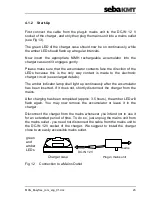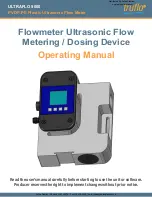
MAN_Easyflex_com_eng_01.doc
35
3.8.3
How to Determine an Unknown Nominal Velocity of
Propagation or Pulse Propagation Velocity
When the nominal velocity of propagation or pulse propagation velocity of
the faulty cable is not known, a test sample of the same type of cable with
known length is needed (or the distance to a specific point in the cable
must be known).
Set the cursor to the foot point of the known reflection. Then adjust the
NVP or pulse velocity setting such that the indicated distance to the fault
correlates with the actual length of the sample. After that the distance to a
fault reflection in the defective cable can be measured.
3.8.4
Simplification of Fault Location Using Comparative Tests
The reflectogram shown in Fig 6 shows cable and fault in virtually ideal
conditions. In reality, however, there are cable junctions and other
connections resulting in a trace which is normally similar to that shown in
Fig 7 (good pair). In Fig. 8 (Faulty pair), in addition to the fault other cable
reflections are visible which are caused commonly by connections with an
impedance different from that of the line. These jumps in impedance also
appear as reflections and thus render the detection of the reflection caused
by the fault almost impossible. When a multi-pair cable is tested, a
comparative test (see Fig 9) using a good pair (provided that not all
conductors are defective) allows the point of fault to be detected. Connect
the good pair to L2, the faulty pair to L1. Then select mode Alt by pressing
key (Line). Move the cursor to the points where both trace diverge. In Fig
10 mode Diff was used which means that differences between both
reflectograms (fault reflections in the defective cable) occur in places where
the difference on display deviates from the horizontal. Use the cursor to
measure the distance to the foot point of the deviation.
















































